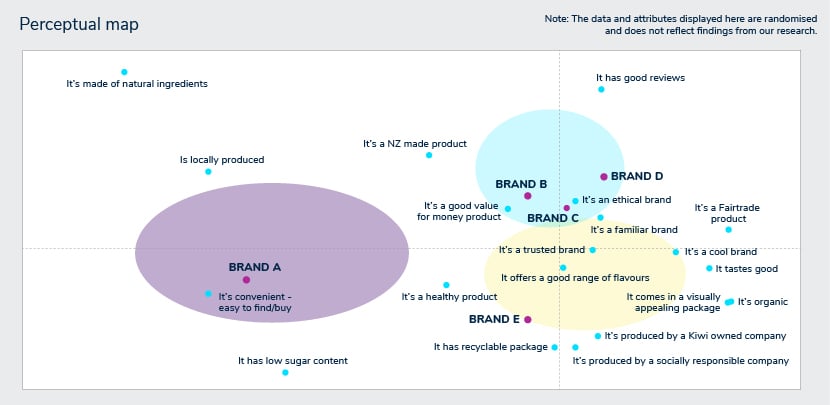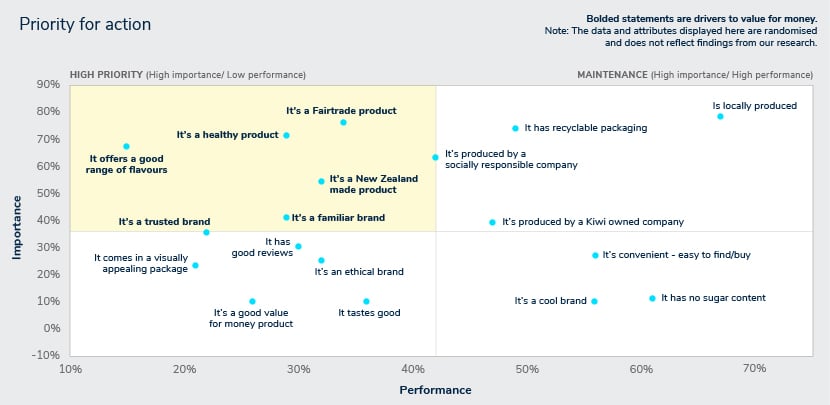Brand attributes are a vital component to brand health. Understanding them helps you hero the features of your brand customers are drawn to, and ultimately make them choose you over a competitor. If you’re new to brand attributes, here’s a 101 on what they are and how to measure, track and use them to the benefit of your brand.

Related content: Learn how to track, measure and improve your brand health with our free guide
What are brand attributes?
Brand attributes are the key characteristics of your brand. If we use gym memberships as an example, brands like Snap Fitness and Jetts may be perceived to be more aligned to “24-hour access” and “convenience”, where as a brand like Les Mills may be linked to the “range of classes” offered and “quality of instructors”. Meanwhile, NextGeneration may be perceived to be more aligned to “lifestyle” and “premium facilities”.
Some of these attributes may be non-negotiables and will outweigh all others, while other attributes you might be willing to forgo so long as the brand (or gym in this case) ticks the must-have boxes. By mapping out these preferences among both your customers and market overall, brands can understand:
- What attributes matter most to consumers (these may include attributes that aren’t part of your brand).
- Which attributes you perform well in—and which ones you don’t.
- What attributes your competitors perform well in—and don’t.
- Attributes that are important to consumers but not 'owned’ by any brand in the market (white space opportunity).
Brand attributes versus brand associations: what’s the difference?
While there can be some overlap between the two, the key difference is brand associations are how a brand is perceived by the market. Meanwhile, brand attributes are the key characteristics that attract customers to a brand. Think of it like describing a friend. You might mention some basic descriptors such as height, hair colour, or gender, along with some personality traits that draws you to that person, such as fun, hard-working, and so on.
How to build, measure and track your brand attributes
Identifying the brand attributes that are considered by consumers and the degree to which they influence decision-making can generally be done using a quantitative online survey. In situations where purchase decisions are complex, you may need to do some exploratory qualitative research first.
Brand attributes are generally measured and monitored over time as part of a brand health tracking programme. The results can be mapped in a variety of ways, from most important to least, as well as how other competitors perform on the same criteria. Here are two examples:
1. A perceptual brand map
This can be used to explore the relationship among brand-related attributes and map your competitive landscape to identify any white space opportunities.

The further an attribute is from the intersect, the more distinct it is. The closer to the intersect, the less distinct. That said, market leaders tend to sit closer to the middle as they perform well across more attributes. Attributes captured in a brand’s radius (note the blue area around Brand B) hold high association with that brand. A brand and attribute are probably negatively associated if they are opposite sides of the map.
2. A ‘Priority for Action’ map
This identifies attributes that are important to customers and how well you perform against those attributes. The red quadrant in the example below shows how the brand in question is underperforming against five attributes deemed most important to their target audience.

With the right brand tracking programme, you can map all your brand attributes and compare them to your competitors to see where you are over and under indexing.
Once you understand what brand attributes you currently ‘own’ and what attributes are important to the market, you can tailor your brand’s messaging and creative to hero those. The next step is to monitor the impact these attributes have over time on performance, allowing you to see how effective your messaging and creative is.
Read more: How to use brand tracking to assess marketing performance
It’s also worth mentioning that you may find your different customer segments have different attribute preferences. To use the gym example again, consumers who are shift workers and busy working professionals may place more value in an attribute like ‘open 24 hours’, while a different subset of consumers may place more emphasis on ‘good range of classes’. Understanding the different attribute preferences for your customer segments means you can create targeted marketing for a particular segment that highlights their preferred attributes.
Understanding the brand attributes for your market and the changes in their performance will help you to better meet customer needs and expectations. In short, this is one brand health metric you don’t want to miss.
A healthy brand is a profitable brand. Learn the ins and outs of brand health with our complete guide to tracking, measuring and improving the performance of your brand.
